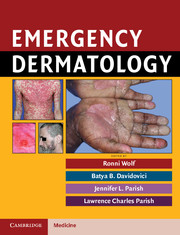Book contents
- Frontmatter
- Contents
- CONTRIBUTORS
- PREFACE
- Chap. 1 CELL INJURY AND CELL DEATH
- Chap. 2 CLEAN AND ASEPTIC TECHNIQUE AT THE BEDSIDE
- Chap. 3 NEW ANTIMICROBIALS
- Chap. 4 IMMUNOMODULATORS AND THE “BIOLOGICS” IN CUTANEOUS EMERGENCIES
- Chap. 5 CRITICAL CARE: STUFF YOU REALLY, REALLY NEED TO KNOW
- Chap. 6 ACUTE SKIN FAILURE: CONCEPT, CAUSES, CONSEQUENCES, AND CARE
- Chap. 7 CUTANEOUS SYMPTOMS AND NEONATAL EMERGENCIES
- Chap. 8 NECROTIZING SOFT-TISSUE INFECTIONS, INCLUDING NECROTIZING FASCIITIS
- Chap. 9 LIFE-THREATENING BACTERIAL SKIN INFECTIONS
- Chap. 10 BACTEREMIA, SEPSIS, SEPTIC SHOCK, AND TOXIC SHOCK SYNDROME
- Chap. 11 STAPHYLOCOCCAL SCALDED SKIN SYNDROME
- Chap. 12 LIFE-THREATENING CUTANEOUS VIRAL DISEASES
- Chap. 13 LIFE-THREATENING CUTANEOUS FUNGAL AND PARASITIC DISEASES
- Chap. 14 LIFE-THREATENING STINGS, BITES, AND MARINE ENVENOMATIONS
- Chap. 15 SEVERE, ACUTE ADVERSE CUTANEOUS DRUG REACTIONS I: STEVENS–JOHNSON SYNDROME AND TOXIC EPIDERMAL NECROLYSIS
- Chap. 16 SEVERE, ACUTE ADVERSE CUTANEOUS DRUG REACTIONS II: DRESS SYNDROME AND SERUM SICKNESS-LIKE REACTION
- Chap. 17 SEVERE, ACUTE COMPLICATIONS OF DERMATOLOGIC THERAPIES
- Chap. 18 SEVERE, ACUTE ALLERGIC AND IMMUNOLOGICAL REACTIONS I: URTICARIA, ANGIOEDEMA, MASTOCYTOSIS, AND ANAPHYLAXIS
- Chap. 19 SEVERE, ACUTE ALLERGIC AND IMMUNOLOGICAL REACTIONS II: OTHER HYPERSENSITIVITIES AND IMMUNE DEFECTS, INCLUDING HIV
- Chap. 20 GRAFT VERSUS HOST DISEASE
- Chap. 21 ERYTHRODERMA/EXFOLIATIVE DERMATITIS
- Chap. 22 ACUTE, SEVERE BULLOUS DERMATOSES
- Chap. 23 EMERGENCY MANAGEMENT OF PURPURA AND VASCULITIS, INCLUDING PURPURA FULMINANS
- Chap. 24 EMERGENCY MANAGEMENT OF CONNECTIVE TISSUE DISORDERS AND THEIR COMPLICATIONS
- Chap. 25 SKIN SIGNS OF SYSTEMIC INFECTIONS
- Chap. 26 SKIN SIGNS OF SYSTEMIC NEOPLASTIC DISEASES AND PARANEOPLASTIC CUTANEOUS SYNDROMES
- Chap. 27 BURN INJURY
- Chap. 28 EMERGENCY DERMATOSES OF THE ANORECTAL REGIONS
- Chap. 29 EMERGENCY MANAGEMENT OF SEXUALLY TRANSMITTED DISEASES AND OTHER GENITOURETHRAL DISORDERS
- Chap. 30 EMERGENCY MANAGEMENT OF ENVIRONMENTAL SKIN DISORDERS: HEAT, COLD, ULTRAVIOLET LIGHT INJURIES
- Chap. 31 ENDOCRINOLOGIC EMERGENCIES IN DERMATOLOGY
- Chap. 32 EMERGENCY MANAGEMENT OF SKIN TORTURE AND SELF-INFLICTED DERMATOSES
- Chap. 33 SKIN SIGNS OF POISONING
- Chap. 34 DISASTER PLANNING: MASS CASUALTY MANAGEMENT
- Chap. 35 CATASTROPHES IN COSMETIC PROCEDURES
- Chap. 36 LIFE-THREATENING DERMATOSES IN TRAVELERS
- Index
- References
Chap. 36 - LIFE-THREATENING DERMATOSES IN TRAVELERS
Published online by Cambridge University Press: 07 September 2011
- Frontmatter
- Contents
- CONTRIBUTORS
- PREFACE
- Chap. 1 CELL INJURY AND CELL DEATH
- Chap. 2 CLEAN AND ASEPTIC TECHNIQUE AT THE BEDSIDE
- Chap. 3 NEW ANTIMICROBIALS
- Chap. 4 IMMUNOMODULATORS AND THE “BIOLOGICS” IN CUTANEOUS EMERGENCIES
- Chap. 5 CRITICAL CARE: STUFF YOU REALLY, REALLY NEED TO KNOW
- Chap. 6 ACUTE SKIN FAILURE: CONCEPT, CAUSES, CONSEQUENCES, AND CARE
- Chap. 7 CUTANEOUS SYMPTOMS AND NEONATAL EMERGENCIES
- Chap. 8 NECROTIZING SOFT-TISSUE INFECTIONS, INCLUDING NECROTIZING FASCIITIS
- Chap. 9 LIFE-THREATENING BACTERIAL SKIN INFECTIONS
- Chap. 10 BACTEREMIA, SEPSIS, SEPTIC SHOCK, AND TOXIC SHOCK SYNDROME
- Chap. 11 STAPHYLOCOCCAL SCALDED SKIN SYNDROME
- Chap. 12 LIFE-THREATENING CUTANEOUS VIRAL DISEASES
- Chap. 13 LIFE-THREATENING CUTANEOUS FUNGAL AND PARASITIC DISEASES
- Chap. 14 LIFE-THREATENING STINGS, BITES, AND MARINE ENVENOMATIONS
- Chap. 15 SEVERE, ACUTE ADVERSE CUTANEOUS DRUG REACTIONS I: STEVENS–JOHNSON SYNDROME AND TOXIC EPIDERMAL NECROLYSIS
- Chap. 16 SEVERE, ACUTE ADVERSE CUTANEOUS DRUG REACTIONS II: DRESS SYNDROME AND SERUM SICKNESS-LIKE REACTION
- Chap. 17 SEVERE, ACUTE COMPLICATIONS OF DERMATOLOGIC THERAPIES
- Chap. 18 SEVERE, ACUTE ALLERGIC AND IMMUNOLOGICAL REACTIONS I: URTICARIA, ANGIOEDEMA, MASTOCYTOSIS, AND ANAPHYLAXIS
- Chap. 19 SEVERE, ACUTE ALLERGIC AND IMMUNOLOGICAL REACTIONS II: OTHER HYPERSENSITIVITIES AND IMMUNE DEFECTS, INCLUDING HIV
- Chap. 20 GRAFT VERSUS HOST DISEASE
- Chap. 21 ERYTHRODERMA/EXFOLIATIVE DERMATITIS
- Chap. 22 ACUTE, SEVERE BULLOUS DERMATOSES
- Chap. 23 EMERGENCY MANAGEMENT OF PURPURA AND VASCULITIS, INCLUDING PURPURA FULMINANS
- Chap. 24 EMERGENCY MANAGEMENT OF CONNECTIVE TISSUE DISORDERS AND THEIR COMPLICATIONS
- Chap. 25 SKIN SIGNS OF SYSTEMIC INFECTIONS
- Chap. 26 SKIN SIGNS OF SYSTEMIC NEOPLASTIC DISEASES AND PARANEOPLASTIC CUTANEOUS SYNDROMES
- Chap. 27 BURN INJURY
- Chap. 28 EMERGENCY DERMATOSES OF THE ANORECTAL REGIONS
- Chap. 29 EMERGENCY MANAGEMENT OF SEXUALLY TRANSMITTED DISEASES AND OTHER GENITOURETHRAL DISORDERS
- Chap. 30 EMERGENCY MANAGEMENT OF ENVIRONMENTAL SKIN DISORDERS: HEAT, COLD, ULTRAVIOLET LIGHT INJURIES
- Chap. 31 ENDOCRINOLOGIC EMERGENCIES IN DERMATOLOGY
- Chap. 32 EMERGENCY MANAGEMENT OF SKIN TORTURE AND SELF-INFLICTED DERMATOSES
- Chap. 33 SKIN SIGNS OF POISONING
- Chap. 34 DISASTER PLANNING: MASS CASUALTY MANAGEMENT
- Chap. 35 CATASTROPHES IN COSMETIC PROCEDURES
- Chap. 36 LIFE-THREATENING DERMATOSES IN TRAVELERS
- Index
- References
Summary
SEVERE SKIN reactions/conditions are of particular concern when the traveler is away from home and medical care is unfamiliar or of uncertain caliber. Perhaps the most significant of these conditions is Stevens–Johnson syndrome, which may occur after the use of antimalarials such as Fansidar® as prophylaxis while traveling in Africa. Travel remains a rapidly growing enterprise with more remote destinations appearing on the radar screen each year, making the previous review a basis for this update.
More commonly, a serious dermatosis begins before the trip, progresses, and becomes significant while the traveler is away from usual medical care, not following his or her usual dietary and health habits, and often has a difficult time finding and/or communicating with medical personnel. Older patients (often the usual travelers with both time and means) have particular challenges – daunting lists of drugs and potential interactions, as well as the possibility of new drugs (and side effects) beginning around the time of the travel. The pediatric population is part of this new trend, and the smaller patients have higher risk in both toxic (venoms) and drug reactions. The occasional traveler rarely keeps important medical documents with him or her, but they are necessary during an acute/life-threatening event, as the following example demonstrates.
- Type
- Chapter
- Information
- Emergency Dermatology , pp. 340 - 344Publisher: Cambridge University PressPrint publication year: 2011

